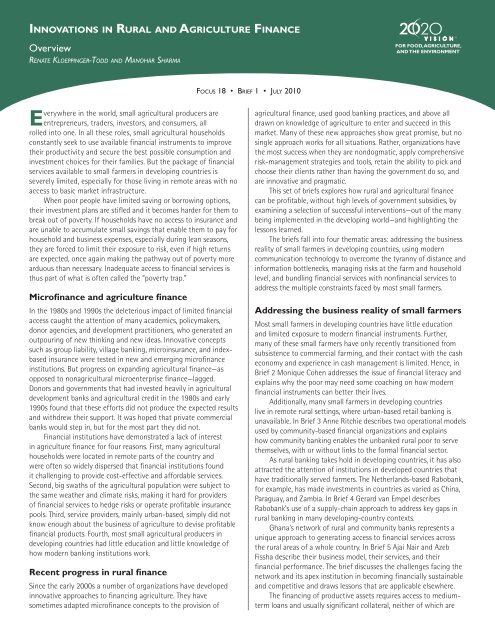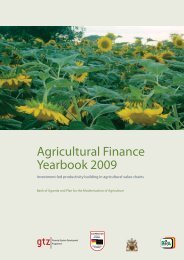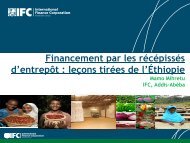Innovations in Rural and Agriculture Finance
Innovations in Rural and Agriculture Finance
Innovations in Rural and Agriculture Finance
Create successful ePaper yourself
Turn your PDF publications into a flip-book with our unique Google optimized e-Paper software.
<strong>Innovations</strong> <strong>in</strong> <strong>Rural</strong> <strong>and</strong> <strong>Agriculture</strong> F<strong>in</strong>anceOverviewRenate Kloepp<strong>in</strong>ger-Todd <strong>and</strong> Manohar SharmaFor Food, <strong>Agriculture</strong>,<strong>and</strong> the EnvironmentFocus 18 • Brief 1 • July 2010Everywhere <strong>in</strong> the world, small agricultural producers areentrepreneurs, traders, <strong>in</strong>vestors, <strong>and</strong> consumers, allrolled <strong>in</strong>to one. In all these roles, small agricultural householdsconstantly seek to use available f<strong>in</strong>ancial <strong>in</strong>struments to improvetheir productivity <strong>and</strong> secure the best possible consumption <strong>and</strong><strong>in</strong>vestment choices for their families. But the package of f<strong>in</strong>ancialservices available to small farmers <strong>in</strong> develop<strong>in</strong>g countries isseverely limited, especially for those liv<strong>in</strong>g <strong>in</strong> remote areas with noaccess to basic market <strong>in</strong>frastructure.When poor people have limited sav<strong>in</strong>g or borrow<strong>in</strong>g options,their <strong>in</strong>vestment plans are stifled <strong>and</strong> it becomes harder for them tobreak out of poverty. If households have no access to <strong>in</strong>surance <strong>and</strong>are unable to accumulate small sav<strong>in</strong>gs that enable them to pay forhousehold <strong>and</strong> bus<strong>in</strong>ess expenses, especially dur<strong>in</strong>g lean seasons,they are forced to limit their exposure to risk, even if high returnsare expected, once aga<strong>in</strong> mak<strong>in</strong>g the pathway out of poverty morearduous than necessary. Inadequate access to f<strong>in</strong>ancial services isthus part of what is often called the “poverty trap.”Microf<strong>in</strong>ance <strong>and</strong> agriculture f<strong>in</strong>anceIn the 1980s <strong>and</strong> 1990s the deleterious impact of limited f<strong>in</strong>ancialaccess caught the attention of many academics, policymakers,donor agencies, <strong>and</strong> development practitioners, who generated anoutpour<strong>in</strong>g of new th<strong>in</strong>k<strong>in</strong>g <strong>and</strong> new ideas. Innovative conceptssuch as group liability, village bank<strong>in</strong>g, micro<strong>in</strong>surance, <strong>and</strong> <strong>in</strong>dexbased<strong>in</strong>surance were tested <strong>in</strong> new <strong>and</strong> emerg<strong>in</strong>g microf<strong>in</strong>ance<strong>in</strong>stitutions. But progress on exp<strong>and</strong><strong>in</strong>g agricultural f<strong>in</strong>ance—asopposed to nonagricultural microenterprise f<strong>in</strong>ance—lagged.Donors <strong>and</strong> governments that had <strong>in</strong>vested heavily <strong>in</strong> agriculturaldevelopment banks <strong>and</strong> agricultural credit <strong>in</strong> the 1980s <strong>and</strong> early1990s found that these efforts did not produce the expected results<strong>and</strong> withdrew their support. It was hoped that private commercialbanks would step <strong>in</strong>, but for the most part they did not.F<strong>in</strong>ancial <strong>in</strong>stitutions have demonstrated a lack of <strong>in</strong>terest<strong>in</strong> agriculture f<strong>in</strong>ance for four reasons. First, many agriculturalhouseholds were located <strong>in</strong> remote parts of the country <strong>and</strong>were often so widely dispersed that f<strong>in</strong>ancial <strong>in</strong>stitutions foundit challeng<strong>in</strong>g to provide cost-effective <strong>and</strong> affordable services.Second, big swaths of the agricultural population were subject tothe same weather <strong>and</strong> climate risks, mak<strong>in</strong>g it hard for providersof f<strong>in</strong>ancial services to hedge risks or operate profitable <strong>in</strong>surancepools. Third, service providers, ma<strong>in</strong>ly urban-based, simply did notknow enough about the bus<strong>in</strong>ess of agriculture to devise profitablef<strong>in</strong>ancial products. Fourth, most small agricultural producers <strong>in</strong>develop<strong>in</strong>g countries had little education <strong>and</strong> little knowledge ofhow modern bank<strong>in</strong>g <strong>in</strong>stitutions work.Recent progress <strong>in</strong> rural f<strong>in</strong>anceS<strong>in</strong>ce the early 2000s a number of organizations have developed<strong>in</strong>novative approaches to f<strong>in</strong>anc<strong>in</strong>g agriculture. They havesometimes adapted microf<strong>in</strong>ance concepts to the provision ofagricultural f<strong>in</strong>ance, used good bank<strong>in</strong>g practices, <strong>and</strong> above alldrawn on knowledge of agriculture to enter <strong>and</strong> succeed <strong>in</strong> thismarket. Many of these new approaches show great promise, but nos<strong>in</strong>gle approach works for all situations. Rather, organizations havethe most success when they are nondogmatic, apply comprehensiverisk-management strategies <strong>and</strong> tools, reta<strong>in</strong> the ability to pick <strong>and</strong>choose their clients rather than hav<strong>in</strong>g the government do so, <strong>and</strong>are <strong>in</strong>novative <strong>and</strong> pragmatic.This set of briefs explores how rural <strong>and</strong> agricultural f<strong>in</strong>ancecan be profitable, without high levels of government subsidies, byexam<strong>in</strong><strong>in</strong>g a selection of successful <strong>in</strong>terventions—out of the manybe<strong>in</strong>g implemented <strong>in</strong> the develop<strong>in</strong>g world—<strong>and</strong> highlight<strong>in</strong>g thelessons learned.The briefs fall <strong>in</strong>to four thematic areas: address<strong>in</strong>g the bus<strong>in</strong>essreality of small farmers <strong>in</strong> develop<strong>in</strong>g countries, us<strong>in</strong>g moderncommunication technology to overcome the tyranny of distance <strong>and</strong><strong>in</strong>formation bottlenecks, manag<strong>in</strong>g risks at the farm <strong>and</strong> householdlevel, <strong>and</strong> bundl<strong>in</strong>g f<strong>in</strong>ancial services with nonf<strong>in</strong>ancial services toaddress the multiple constra<strong>in</strong>ts faced by most small farmers.Address<strong>in</strong>g the bus<strong>in</strong>ess reality of small farmersMost small farmers <strong>in</strong> develop<strong>in</strong>g countries have little education<strong>and</strong> limited exposure to modern f<strong>in</strong>ancial <strong>in</strong>struments. Further,many of these small farmers have only recently transitioned fromsubsistence to commercial farm<strong>in</strong>g, <strong>and</strong> their contact with the casheconomy <strong>and</strong> experience <strong>in</strong> cash management is limited. Hence, <strong>in</strong>Brief 2 Monique Cohen addresses the issue of f<strong>in</strong>ancial literacy <strong>and</strong>expla<strong>in</strong>s why the poor may need some coach<strong>in</strong>g on how modernf<strong>in</strong>ancial <strong>in</strong>struments can better their lives.Additionally, many small farmers <strong>in</strong> develop<strong>in</strong>g countrieslive <strong>in</strong> remote rural sett<strong>in</strong>gs, where urban-based retail bank<strong>in</strong>g isunavailable. In Brief 3 Anne Ritchie describes two operational modelsused by community-based f<strong>in</strong>ancial organizations <strong>and</strong> expla<strong>in</strong>show community bank<strong>in</strong>g enables the unbanked rural poor to servethemselves, with or without l<strong>in</strong>ks to the formal f<strong>in</strong>ancial sector.As rural bank<strong>in</strong>g takes hold <strong>in</strong> develop<strong>in</strong>g countries, it has alsoattracted the attention of <strong>in</strong>stitutions <strong>in</strong> developed countries thathave traditionally served farmers. The Netherl<strong>and</strong>s-based Rabobank,for example, has made <strong>in</strong>vestments <strong>in</strong> countries as varied as Ch<strong>in</strong>a,Paraguay, <strong>and</strong> Zambia. In Brief 4 Gerard van Empel describesRabobank’s use of a supply-cha<strong>in</strong> approach to address key gaps <strong>in</strong>rural bank<strong>in</strong>g <strong>in</strong> many develop<strong>in</strong>g-country contexts.Ghana’s network of rural <strong>and</strong> community banks represents aunique approach to generat<strong>in</strong>g access to f<strong>in</strong>ancial services acrossthe rural areas of a whole country. In Brief 5 Ajai Nair <strong>and</strong> AzebFissha describe their bus<strong>in</strong>ess model, their services, <strong>and</strong> theirf<strong>in</strong>ancial performance. The brief discusses the challenges fac<strong>in</strong>g thenetwork <strong>and</strong> its apex <strong>in</strong>stitution <strong>in</strong> becom<strong>in</strong>g f<strong>in</strong>ancially susta<strong>in</strong>able<strong>and</strong> competitive <strong>and</strong> draws lessons that are applicable elsewhere.The f<strong>in</strong>anc<strong>in</strong>g of productive assets requires access to mediumtermloans <strong>and</strong> usually significant collateral, neither of which are







